List of mammals of Mexico
This is a list of the native wild mammal species recorded in Mexico. As of September 2014, there were 536 mammalian species or subspecies listed. Based on IUCN data, Mexico has 23% more noncetacean mammal species than the U.S. and Canada combined in an area only 10% as large, or a species density over 12 times that of its northern neighbors.[n 1] Mexico's high mammal biodiversity is in part a reflection of the wide array of biomes present over its latitudinal, climatic and altitudinal ranges, from lowland tropical rainforest to temperate desert to montane forest to alpine tundra. The general increase in terrestrial biodiversity moving towards the equator[1] is another important factor in the comparison. Mexico includes much of the Mesoamerican and Madrean pine-oak woodlands biodiversity hotspots. From a biogeographic standpoint, most of Mexico is linked to the rest of North America as part of the Nearctic ecozone. However, the lowlands of southern Mexico are linked with Central America and South America as part of the Neotropic ecozone. Extensive mixing of Nearctic and Neotropical mammal species commenced only three million years ago, when the formation of the Isthmus of Panama ended South America's long period of isolation and precipitated the Great American Interchange. Twenty of Mexico's extant nonflying species (opossums, armadillos, anteaters, monkeys and caviomorph rodents) are of South American origin. Most of the megafauna that formerly inhabited the region became extinct at the end of the Pleistocene about 10,000 years ago, shortly after the arrival of the first humans. Increasing alteration and destruction of natural habitats by expanding human populations during the last several centuries is causing further attrition of the region's biodiversity, as exemplified by the 'hotspot' designations (by definition, such areas have lost over 70% of their primary vegetation).
The following tags are used to highlight each species' conservation status as assessed by the IUCN:
| EX | Extinct | No reasonable doubt that the last individual has died. |
| EW | Extinct in the wild | Known only to survive in captivity or as a naturalized population well outside its historic range. |
| CR | Critically endangered | The species is in imminent danger of extinction in the wild. |
| EN | Endangered | The species is facing a very high risk of extinction in the wild. |
| VU | Vulnerable | The species is facing a high risk of extinction in the wild. |
| NT | Near threatened | The species does not qualify as being at high risk of extinction but is likely to do so in the future. |
| LC | Least concern | The species is not currently at risk of extinction in the wild. |
| DD | Data deficient | There is inadequate information to assess the risk of extinction for this species. |
| NE | Not evaluated | The conservation status of the species has not been studied. |
Of the listed taxa, 7 are extinct, 1 (not recognized by the IUCN) is possibly extinct, 30 are critically endangered, 46 are endangered, 26 are vulnerable, and 23 are near-threatened.[n 2] These status tags were most recently updated in April 2011. Six of the extinct or possibly extinct taxa and 11 of the critically endangered taxa are insular (all but two of these are rodents); another 13 of the critically endangered species (all rodents or shrews) are montane. The only critically endangered species that are neither rodents nor shrews are the Cozumel Island raccoon and the Gulf of California harbor porpoise or vaquita. The vaquita population estimate has dropped below 100 as of 2014 and it is regarded as being in imminent danger of extinction.[2][3]
Subclass: Theria
Infraclass: Metatheria
Marsupials are an infraclass of pouched mammals that was once more widely distributed. Today they are found primarily in isolated or formerly isolated continents of Gondwanan origin. Mexico's opossums are relatively recent immigrants from South America. Mexico's 7 marsupial genera compare to 1 in North America north of Mexico, 10 in Central America, 22 in South America, 52 in Australia, 28 in New Guinea and 2 in Sulawesi. South American marsupials are thought to be ancestral to those of Australia and elsewhere.
Superorder: Ameridelphia
Order: Didelphimorphia (common opossums)
Didelphimorphia is the order of common opossums of the Western Hemisphere. Opossums probably diverged from the basic South American marsupials in the late Cretaceous or early Paleocene.They are small to medium-sized marsupials, about the size of a large house cat, with a long snout and prehensile tail.
- Family: Didelphidae (American opossums)
- Subfamily: Caluromyinae
- Genus: Caluromys
- Derby's woolly opossum, Caluromys derbianus LC
- Genus: Caluromys
- Subfamily: Didelphinae
- Genus: Chironectes
- Water opossum, Chironectes minimus LC
- Genus: Didelphis
- Common opossum, Didelphis marsupialis LC
- Virginia opossum, Didelphis virginiana LC
- Genus: Marmosa
- Mexican mouse opossum, Marmosa mexicana LC
- Genus: Metachirus
- Brown four-eyed opossum, Metachirus nudicaudatus LC
- Genus: Philander
- Gray four-eyed opossum, Philander opossum LC
- Genus: Tlacuatzin
- Grayish mouse opossum, Tlacuatzin canescens LC
- Genus: Chironectes
- Subfamily: Caluromyinae
Infraclass: Eutheria
Superorder: Afrotheria
Order: Sirenia (manatees and dugongs)
Sirenia is an order of fully aquatic, herbivorous mammals that inhabit rivers, estuaries, coastal marine waters, swamps, and marine wetlands. All four species are endangered. They evolved about 50 million years ago, and their closest living relatives are elephants. Manatees are the only extant afrotherians in the Americas. However, a number proboscid species, some of which survived until the arrival of Paleo-Indians, once inhabited the region. Mammoths, mastodons and gomphotheres all formerly lived in Mexico.[4][5]
- Family: Trichechidae
- Genus: Trichechus
- West Indian manatee, Trichechus manatus VU
- Genus: Trichechus
Superorder: Xenarthra
Order: Cingulata (armadillos)
Armadillos are small mammals with a bony armored shell. Two of 21 extant species are present in Mexico; the remainder are only found in South America, where they originated. Their much larger relatives, the pampatheres and glyptodonts, once lived in North and South America but went extinct following the appearance of humans.
- Family: Dasypodidae (long-nosed armadillos)
- Subfamily: Dasypodinae
- Genus: Dasypus
- Nine-banded armadillo, Dasypus novemcinctus LC
- Genus: Dasypus
- Subfamily: Dasypodinae
- Family: Chlamyphoridae (armadillos)
- Subfamily: Tolypeutinae
- Genus: Cabassous
- Northern naked-tailed armadillo, Cabassous centralis DD
- Genus: Cabassous
- Subfamily: Tolypeutinae
Order: Pilosa (anteaters, sloths and tamanduas)
The order Pilosa is extant only in the Americas and includes the anteaters, sloths, and tamanduas. Their ancestral home is South America. Numerous ground sloths, some of which reached the size of elephants, were once present in both North and South America, as well as on the Antilles, but all went extinct following the arrival of humans.
- Suborder: Vermilingua
- Family: Cyclopedidae
- Genus: Cyclopes
- Silky anteater, Cyclopes didactylus LC
- Genus: Cyclopes
- Family: Myrmecophagidae (American anteaters)
- Genus: Tamandua
- Northern tamandua, Tamandua mexicana LC
- Genus: Tamandua
- Family: Cyclopedidae
Superorder: Euarchontoglires
Order: Primates
The order Primates includes the lemurs, monkeys, and apes, with the latter category including humans. It is divided into four main groupings: strepsirrhines, tarsiers, monkeys of the New World (parvorder Platyrrhini), and monkeys and apes of the Old World. Mexico's 2 genera of nonhuman primates compares to 6 in Central America, 20 in South America, 15 in Madagascar, 23 in Africa and 19 in Asia. Mexican and Central American monkeys are recent immigrants from South America, where their ancestors arrived after rafting over from Africa roughly 25 million years ago.[6] Southeastern Mexico is the northernmost limit of the distribution of New World monkeys, which are restricted to tropical rainforest habitat.
- Suborder: Haplorrhini
- Infraorder: Simiiformes
- Parvorder: Platyrrhini
- Family: Atelidae
- Subfamily: Alouattinae
- Genus: Alouatta
- Mantled howler, Alouatta palliata LC
- Guatemalan black howler, Alouatta pigra EN
- Genus: Alouatta
- Subfamily: Atelinae
- Genus: Ateles
- Geoffroy's spider monkey, Ateles geoffroyi EN
- Genus: Ateles
- Subfamily: Alouattinae
- Family: Atelidae
- Parvorder: Platyrrhini
- Infraorder: Simiiformes
Order: Rodentia (rodents)
Rodents make up the largest order of mammals, with over 40 percent of mammalian species. They have two incisors in the upper and lower jaw which grow continually and must be keep short by gnawing. Most rodents are small, although the capybara can weigh up to 45 kg (100 lb). According to the IUCN listing, Mexico has more rodent species (236 as of April 2011) than any other country in the world (Brazil is second with 222). Of Mexico's rodents, 2% are caviomorphs, 14.5% are sciurids, 25.5% are castorimorphs and 58% are cricetids. This distribution is fairly similar to that of the remainder of North America (although sciurids are relatively twice as abundant to the north, at the expense of cricetids), but is very different from that of South America, where the corresponding figures are 36%, 3%, 1% and 60%. Of Mexico's cricetids, 17% are sigmodontine, while the figure for South America is 99.5%.[n 3] Mexico's caviomorphs are recent immigrants from South America, where their ancestors washed ashore after rafting across the Atlantic from Africa about 40–45 million years ago.[6][7] Conversely, South America's sciurids, castorimorphs and cricetids are recent immigrants from Central America (with sigmodontines getting a head start on the others).
- Suborder: Hystricomorpha
- Parvorder: Caviomorpha
- Family: Erethizontidae (New World porcupines)
- Subfamily: Erethizontinae
- Genus: Erethizon
- North American porcupine, Erethizon dorsatum LC
- Genus: Coendou
- Mexican hairy dwarf porcupine, Coendou mexicanus LC
- Genus: Erethizon
- Subfamily: Erethizontinae
- Family: Dasyproctidae (agoutis and pacas)
- Genus: Dasyprocta
- Mexican agouti, Dasyprocta mexicana CR
- Central American agouti, Dasyprocta punctata LC
- Genus: Dasyprocta
- Family: Cuniculidae
- Genus: Cuniculus
- Lowland paca, Cuniculus paca LC
- Genus: Cuniculus
- Family: Erethizontidae (New World porcupines)
- Parvorder: Caviomorpha
- Suborder: Sciuromorpha
- Family: Sciuridae (squirrels)
- Subfamily: Sciurinae
- Tribe: Pteromyini
- Genus: Glaucomys
- Southern flying squirrel, Glaucomys volans LC
- Genus: Glaucomys
- Tribe: Sciurini
- Genus: Sciurus
- Abert's squirrel, Sciurus aberti LC
- Allen's squirrel, Sciurus alleni LC
- Arizona gray squirrel, Sciurus arizonensis DD
- Mexican gray squirrel, Sciurus aureogaster LC
- Collie's squirrel, Sciurus colliaei LC
- Deppe's squirrel, Sciurus deppei LC
- Western gray squirrel, Sciurus griseus LC
- Mexican fox squirrel, Sciurus nayaritensis LC
- Fox squirrel, Sciurus niger LC
- Peters's squirrel, Sciurus oculatus LC
- Variegated squirrel, Sciurus variegatoides LC
- Yucatan squirrel, Sciurus yucatanensis LC
- Genus: Tamiasciurus
- Mearns's squirrel, Tamiasciurus mearnsi EN
- Genus: Sciurus
- Tribe: Pteromyini
- Subfamily: Xerinae
- Tribe: Marmotini
- Genus: Ammospermophilus
- Harris's antelope squirrel, Ammospermophilus harrisii LC
- Espíritu Santo antelope squirrel, Ammospermophilus insularis
- Texas antelope squirrel, Ammospermophilus interpres LC
- White-tailed antelope squirrel, Ammospermophilus leucurus LC
- Genus: Cynomys
- Black-tailed prairie dog, Cynomys ludovicianus LC
- Mexican prairie dog, Cynomys mexicanus EN
- Genus: Neotamias
- Buller's chipmunk, Neotamias bulleri VU
- Cliff chipmunk, Neotamias dorsalis LC
- Durango chipmunk, Neotamias durangae LC
- Merriam's chipmunk, Neotamias merriami LC
- California chipmunk, Neotamias obscurus LC
- Genus: Spermophilus
- Tropical ground squirrel, Spermophilus adocetus LC
- Ring-tailed ground squirrel, Spermophilus annulatus LC
- Baja California rock squirrel, Spermophilus atricapillus EN
- California ground squirrel, Spermophilus beecheyi LC
- Sierra Madre ground squirrel, Spermophilus madrensis NT
- Mexican ground squirrel, Spermophilus mexicanus LC
- Perote ground squirrel, Spermophilus perotensis EN
- Spotted ground squirrel, Spermophilus spilosoma LC
- Round-tailed ground squirrel, Spermophilus tereticaudus LC
- Rock squirrel, Spermophilus variegatus LC
- Genus: Ammospermophilus
- Tribe: Marmotini
- Subfamily: Sciurinae
- Family: Sciuridae (squirrels)
- Suborder: Castorimorpha
- Family: Castoridae (beavers)
- Genus: Castor
- American beaver, Castor canadensis LC
- Genus: Castor
- Family: Geomyidae
- Genus: Cratogeomys
- Yellow-faced pocket gopher, Cratogeomys castanops LC
- Cratogeomys fulvescens LC
- Smoky pocket gopher, Cratogeomys fumosus LC
- Goldman's pocket gopher, Cratogeomys goldmani LC
- Merriam's pocket gopher, Cratogeomys merriami LC
- Cratogeomys perotensis LC
- Cratogeomys planiceps LC
- Genus: Geomys
- Desert pocket gopher, Geomys arenarius NT
- Texas pocket gopher, Geomys personatus LC
- Tropical pocket gopher, Geomys tropicalis CR
- Genus: Orthogeomys
- Oaxacan pocket gopher, Orthogeomys cuniculus DD
- Giant pocket gopher, Orthogeomys grandis LC
- Hispid pocket gopher, Orthogeomys hispidus LC
- Big pocket gopher, Orthogeomys lanius CR
- Genus: Pappogeomys
- Alcorn's pocket gopher, Pappogeomys alcorni CR
- Buller's pocket gopher, Pappogeomys bulleri LC
- Genus: Thomomys
- Botta's pocket gopher, Thomomys bottae LC
- Southern pocket gopher, Thomomys umbrinus LC
- Genus: Zygogeomys
- Michoacan pocket gopher, Zygogeomys trichopus EN
- Genus: Cratogeomys
- Family: Heteromyidae
- Subfamily: Dipodomyinae
- Genus: Dipodomys
- Agile kangaroo rat, Dipodomys agilis LC
- Gulf Coast kangaroo rat, Dipodomys compactus LC
- Desert kangaroo rat, Dipodomys deserti LC
- San Quintin kangaroo rat, Dipodomys gravipes CR
- San Jose Island kangaroo rat, Dipodomys insularis CR
- Margarita Island kangaroo rat, Dipodomys margaritae CR
- Merriam's kangaroo rat, Dipodomys merriami LC
- Nelson's kangaroo rat, Dipodomys nelsoni LC
- Ord's kangaroo rat, Dipodomys ordii LC
- Phillips' kangaroo rat, Dipodomys phillipsii LC
- Dulzura kangaroo rat, Dipodomys simulans LC
- Banner-tailed kangaroo rat, Dipodomys spectabilis NT
- Genus: Dipodomys
- Subfamily: Heteromyinae
- Genus: Heteromys
- Desmarest's spiny pocket mouse, Heteromys desmarestianus LC
- Gaumer's spiny pocket mouse, Heteromys gaumeri LC
- Mexican spiny pocket mouse, Heteromys irroratus LC
- Nelson's spiny pocket mouse, Heteromys nelsoni EN
- Painted spiny pocket mouse, Heteromys pictus LC
- Salvin's spiny pocket mouse, Heteromys salvini LC
- Jaliscan spiny pocket mouse, Heteromys spectabilis EN
- Genus: Heteromys
- Subfamily: Perognathinae
- Genus: Chaetodipus
- Little desert pocket mouse, Chaetodipus arenarius LC
- Narrow-skulled pocket mouse, Chaetodipus artus LC
- Bailey's pocket mouse, Chaetodipus baileyi LC
- California pocket mouse, Chaetodipus californicus LC
- Dalquest's pocket mouse, Chaetodipus dalquesti VU
- Chihuahuan pocket mouse, Chaetodipus eremicus LC
- San Diego pocket mouse, Chaetodipus fallax LC
- Long-tailed pocket mouse, Chaetodipus formosus LC
- Goldman's pocket mouse, Chaetodipus goldmani NT
- Hispid pocket mouse, Chaetodipus hispidus LC
- Rock pocket mouse, Chaetodipus intermedius LC
- Lined pocket mouse, Chaetodipus lineatus DD
- Nelson's pocket mouse, Chaetodipus nelsoni LC
- Desert pocket mouse, Chaetodipus penicillatus LC
- Sinaloan pocket mouse, Chaetodipus pernix LC
- Baja pocket mouse, Chaetodipus rudinoris LC
- Spiny pocket mouse, Chaetodipus spinatus LC
- Genus: Perognathus
- Arizona pocket mouse, Perognathus amplus LC
- Plains pocket mouse, Perognathus flavescens LC
- Silky pocket mouse, Perognathus flavus LC
- Little pocket mouse, Perognathus longimembris LC
- Merriam's pocket mouse, Perognathus merriami LC
- Genus: Chaetodipus
- Subfamily: Dipodomyinae
- Family: Castoridae (beavers)
- Suborder: Myomorpha
- Family: Cricetidae
- Subfamily: Arvicolinae
- Genus: Microtus
- California vole, Microtus californicus LC
- Guatemalan vole, Microtus guatemalensis NT
- Mexican vole, Microtus mexicanus LC
- Tarabundí vole, Microtus oaxacensis EN
- Meadow vole, Microtus pennsylvanicus LC
- Jalapan pine vole, Microtus quasiater NT
- Zempoaltépec vole, Microtus umbrosus EN
- Genus: Ondatra
- Muskrat, Ondatra zibethicus LC
- Genus: Microtus
- Subfamily: Tylomyinae
- Genus: Nyctomys
- Sumichrast's vesper rat, Nyctomys sumichrasti LC
- Genus: Otonyctomys
- Hatt's vesper rat, Otonyctomys hatti LC
- Genus: Ototylomys
- Big-eared climbing rat, Ototylomys phyllotis LC
- Genus: Tylomys
- Chiapan climbing rat, Tylomys bullaris CR
- Peters's climbing rat, Tylomys nudicaudus LC
- Tumbala climbing rat, Tylomys tumbalensis CR
- Genus: Nyctomys
- Subfamily: Neotominae
- Genus: Baiomys
- Southern pygmy mouse, Baiomys musculus LC
- Northern pygmy mouse, Baiomys taylori LC
- Genus: Habromys
- Chinanteco deer mouse, Habromys chinanteco CR
- Delicate deer mouse, Habromys delicatulus CR
- Ixtlán deer mouse, Habromys ixtlani CR
- Zempoaltepec deer mouse, Habromys lepturus CR
- Crested-tailed deer mouse, Habromys lophurus NT
- Habromys schmidlyi CR
- Jico deer mouse, Habromys simulatus EN
- Genus: Hodomys
- Allen's wood rat, Hodomys alleni LC
- Genus: Megadontomys
- Oaxaca giant deer mouse, Megadontomys cryophilus EN
- Nelson's giant deer mouse, Megadontomys nelsoni EN
- Thomas's giant deer mouse, Megadontomys thomasi EN
- Genus: Nelsonia
- Goldman's diminutive woodrat, Nelsonia goldmani EN
- Diminutive woodrat, Nelsonia neotomodon NT
- Genus: Neotoma
- White-throated woodrat, Neotoma albigula LC
- Tamaulipan woodrat, Neotoma angustapalata EN
- Anthony's woodrat, Neotoma anthonyi EX
- Bryant's woodrat, Neotoma bryanti EN
- Bunker's woodrat, Neotoma bunkeri EX
- Arizona woodrat, Neotoma devia LC
- Dusky-footed woodrat, Neotoma fuscipes LC
- Goldman's woodrat, Neotoma goldmani LC
- Desert woodrat, Neotoma lepida LC
- White-toothed woodrat, Neotoma leucodon LC
- Big-eared woodrat, Neotoma macrotis LC
- San Martin Island woodrat, Neotoma martinensis EX
- Mexican woodrat, Neotoma mexicana LC
- Southern plains woodrat, Neotoma micropus LC
- Nelson's woodrat, Neotoma nelsoni CR
- Bolaños woodrat, Neotoma palatina VU
- Sonoran woodrat, Neotoma phenax NT
- Turner Island woodrat, Neotoma albigula varia
- Genus: Neotomodon
- Mexican volcano mouse, Neotomodon alstoni LC
- Genus: Osgoodomys
- Michoacan deer mouse, Osgoodomys banderanus LC
- Genus: Peromyscus
- Aztec mouse, Peromyscus aztecus LC
- Peromyscus beatae LC
- Brush mouse, Peromyscus boylii LC
- Perote mouse, Peromyscus bullatus CR
- California mouse, Peromyscus californicus LC
- Burt's deer mouse, Peromyscus caniceps CR
- Canyon mouse, Peromyscus crinitus LC
- Dickey's deer mouse, Peromyscus dickeyi CR
- Zacatecan deer mouse, Peromyscus difficilis LC
- Cactus mouse, Peromyscus eremicus LC
- Eva's desert mouse, Peromyscus eva LC
- Peromyscus fraterculus LC
- Blackish deer mouse, Peromyscus furvus DD
- Osgood's mouse, Peromyscus gratus LC
- Angel Island mouse, Peromyscus guardia CR
- Guatemalan deer mouse, Peromyscus guatemalensis LC
- Naked-eared deer mouse, Peromyscus gymnotis LC
- Hooper's mouse, Peromyscus hooperi LC
- Peromyscus hylocetes LC
- San Lorenzo mouse, Peromyscus interparietalis CR
- White-footed mouse, Peromyscus leucopus LC
- Nimble-footed mouse, Peromyscus levipes LC
- Tres Marias Island mouse, Peromyscus madrensis EN
- Deer mouse, Peromyscus maniculatus LC
- Brown deer mouse, Peromyscus megalops LC
- Puebla deer mouse, Peromyscus mekisturus CR
- Zempoaltepec, Peromyscus melanocarpus EN
- Plateau mouse, Peromyscus melanophrys LC
- Black-eared mouse, Peromyscus melanotis LC
- Black-tailed mouse, Peromyscus melanurus EN
- Mesquite mouse, Peromyscus merriami LC
- Mexican deer mouse, Peromyscus mexicanus LC
- Northern rock mouse, Peromyscus nasutus LC
- El Carrizo deer mouse, Peromyscus ochraventer EN
- White-ankled mouse, Peromyscus pectoralis LC
- Pemberton's deer mouse, Peromyscus pembertoni EX
- Tawny deer mouse, Peromyscus perfulvus LC
- Chihuahuan mouse, Peromyscus polius NT
- False canyon mouse, Peromyscus pseudocrinitus CR
- Peromyscus sagax DD
- Schmidly's deer mouse, Peromyscus schmidlyi LC
- Santa Cruz mouse, Peromyscus sejugis EN
- Nayarit mouse, Peromyscus simulus VU
- Slevin's mouse, Peromyscus slevini CR
- Gleaning mouse, Peromyscus spicilegus LC
- San Esteban Island mouse, Peromyscus stephani CR
- Pinyon mouse, Peromyscus truei LC
- Winkelmann's mouse, Peromyscus winkelmanni EN
- Yucatan deer mouse, Peromyscus yucatanicus LC
- Chiapan deer mouse, Peromyscus zarhynchus VU
- Genus: Reithrodontomys
- Reithrodontomys bakeri EN
- Sonoran harvest mouse, Reithrodontomys burti DD
- Volcano harvest mouse, Reithrodontomys chrysopsis LC
- Fulvous harvest mouse, Reithrodontomys fulvescens LC
- Slender harvest mouse, Reithrodontomys gracilis LC
- Hairy harvest mouse, Reithrodontomys hirsutus VU
- Western harvest mouse, Reithrodontomys megalotis LC
- Mexican harvest mouse, Reithrodontomys mexicanus LC
- Small-toothed harvest mouse, Reithrodontomys microdon LC
- Plains harvest mouse, Reithrodontomys montanus LC
- Cozumel harvest mouse, Reithrodontomys spectabilis CR
- Sumichrast's harvest mouse, Reithrodontomys sumichrasti LC
- Narrow-nosed harvest mouse, Reithrodontomys tenuirostris VU
- Zacatecas harvest mouse, Reithrodontomys zacatecae LC
- Genus: Scotinomys
- Alston's brown mouse, Scotinomys teguina LC
- Genus: Xenomys
- Magdalena rat, Xenomys nelsoni EN
- Genus: Baiomys
- Subfamily: Sigmodontinae
- Genus: Handleyomys
- Alfaro's rice rat, Handleyomys alfaroi LC
- Chapman's rice rat, Handleyomys chapmani LC
- Black-eared rice rat, Handleyomys melanotis LC
- Striped rice rat, Handleyomys rhabdops VU
- Long-nosed rice rat, Handleyomys rostratus LC
- Cloud forest rice rat, Handleyomys saturatior NT
- Genus: Oligoryzomys
- Fulvous pygmy rice rat, Oligoryzomys fulvescens LC
- Genus: Onychomys
- Chihuahuan grasshopper mouse, Onychomys arenicola LC
- Northern grasshopper mouse, Onychomys leucogaster LC
- Southern grasshopper mouse, Onychomys torridus LC
- Genus: Oryzomys
- White-bellied rice rat, Oryzomys albiventer
- Coues' rice rat, Oryzomys couesi LC
- Nelson's rice rat, Oryzomys nelsoni EX
- Marsh rice rat, Oryzomys palustris LC
- Lower California rice rat, Oryzomys peninsulae
- Genus: Rheomys
- Mexican water mouse, Rheomys mexicanus EN
- Thomas's water mouse, Rheomys thomasi NT
- Genus: Sigmodon
- Allen's cotton rat, Sigmodon alleni VU
- Arizona cotton rat, Sigmodon arizonae LC
- Tawny-bellied cotton rat, Sigmodon fulviventer LC
- Southern cotton rat, Sigmodon hirsutus LC
- White-eared cotton rat, Sigmodon leucotis LC
- Jaliscan cotton rat, Sigmodon mascotensis LC
- Yellow-nosed cotton rat, Sigmodon ochrognathus LC
- Miahuatlán cotton rat, Sigmodon planifrons EN
- Toltec cotton rat, Sigmodon toltecus LC
- Genus: Handleyomys
- Subfamily: Arvicolinae
- Family: Cricetidae
Order: Lagomorpha (lagomorphs)
The lagomorphs comprise two families, Leporidae (hares and rabbits), and Ochotonidae (pikas). Though they can resemble rodents, and were classified as a superfamily in that order until the early 20th century, they have since been considered a separate order. They differ from rodents in a number of physical characteristics, such as having four incisors in the upper jaw rather than two. The endangered volcano rabbit of the Trans-Mexican Volcanic Belt is the world's second smallest rabbit. In North America, pikas are not found south of southern California and northern New Mexico.
- Family: Leporidae (rabbits, hares)
- Genus: Romerolagus
- Volcano rabbit, Romerolagus diazi EN
- Genus: Sylvilagus
- Desert cottontail, Sylvilagus audubonii LC
- Brush rabbit, Sylvilagus bachmani LC
- Tapeti, Sylvilagus brasiliensis LC
- Mexican cottontail, Sylvilagus cunicularius LC
- Eastern cottontail, Sylvilagus floridanus LC
- Tres Marias cottontail, Sylvilagus graysoni EN
- Omilteme cottontail, Sylvilagus insonus EN
- San Jose brush rabbit, Sylvilagus mansuetus NT
- Robust cottontail, Sylvilagus robustus EN
- Genus: Lepus
- Antelope jackrabbit, Lepus alleni LC
- Black-tailed jackrabbit, Lepus californicus LC
- White-sided jackrabbit, Lepus callotis NT
- Tehuantepec jackrabbit, Lepus flavigularis EN
- Black jackrabbit, Lepus insularis NT
- Genus: Romerolagus
Superorder: Laurasiatheria
Order: Eulipotyphla (shrews, hedgehogs, moles, and solenodons)
Eulipotyphlans are insectivorous mammals. Shrews and solenodons closely resemble mice, hedgehogs carry spines, while moles are stout-bodied burrowers. In the Americas, moles are not present south of the northernmost tier of Mexican states, where they are rare.
- Family: Soricidae (shrews)
- Subfamily: Soricinae
- Tribe: Blarinini
- Genus: Cryptotis
- Central Mexican broad-clawed shrew, Cryptotis alticola DD
- Goldman's broad-clawed shrew, Cryptotis goldmani LC
- Goodwin's broad-clawed shrew, Cryptotis goodwini LC
- Guatemalan broad-clawed shrew, Cryptotis griseoventris VU
- Big Mexican small-eared shrew, Cryptotis magna VU
- Yucatan small-eared shrew, Cryptotis mayensis LC
- Merriam's small-eared shrew, Cryptotis merriami LC
- Mexican small-eared shrew, Cryptotis mexicana LC
- Nelson's small-eared shrew, Cryptotis nelsoni CR
- Grizzled Mexican small-eared shrew, Cryptotis obscura VU
- North American least shrew, Cryptotis parva LC
- Oaxacan broad-clawed shrew, Cryptotis peregrina DD
- Phillips' small-eared shrew, Cryptotis phillipsii VU
- Tropical small-eared shrew, Cryptotis tropicalis DD
- Genus: Cryptotis
- Tribe: Notiosoricini
- Genus: Megasorex
- Mexican shrew, Megasorex gigas LC
- Genus: Notiosorex
- Cockrum's gray shrew, Notiosorex cockrumi LC
- Crawford's gray shrew, Notiosorex crawfordi LC
- Large-eared gray shrew, Notiosorex evotis LC
- Villa's gray shrew, Notiosorex villai VU
- Genus: Megasorex
- Tribe: Soricini
- Genus: Sorex
- Arizona shrew, Sorex arizonae LC
- Zacatecas shrew, Sorex emarginatus LC
- Sorex ixtlanensis DD
- Large-toothed shrew, Sorex macrodon VU
- Sorex mediopua LC
- Carmen Mountain shrew, Sorex milleri VU
- Montane shrew, Sorex monticolus LC
- Mexican long-tailed shrew, Sorex oreopolus LC
- Orizaba long-tailed shrew, Sorex orizabae LC
- Ornate shrew, Sorex ornatus LC
- Saussure's shrew, Sorex saussurei LC
- Sclater's shrew, Sorex sclateri CR
- San Cristobal shrew, Sorex stizodon CR
- Chestnut-bellied shrew, Sorex ventralis LC
- Veracruz shrew, Sorex veraecrucis LC
- Verapaz shrew, Sorex veraepacis LC
- Genus: Sorex
- Tribe: Blarinini
- Subfamily: Soricinae
- Family: Talpidae (moles)
- Subfamily: Scalopinae
- Tribe: Scalopini
- Genus: Scalopus
- Eastern mole, Scalopus aquaticus LC
- Genus: Scapanus
- Broad-footed mole, Scapanus latimanus LC
- Genus: Scalopus
- Tribe: Scalopini
- Subfamily: Scalopinae
Order: Chiroptera (bats)
The bats' most distinguishing feature is that their forelimbs are developed as wings, making them the only mammals in the world naturally capable of flight. Bat species account for about 20% of all mammals.
- Family: Noctilionidae
- Genus: Noctilio
- Lesser bulldog bat, Noctilio albiventris LC
- Greater bulldog bat, Noctilio leporinus LC
- Genus: Noctilio
- Family: Vespertilionidae
- Subfamily: Myotinae
- Genus: Lasionycteris
- Silver-haired bat, Lasionycteris noctivagans LC
- Genus: Myotis
- Silver-tipped myotis, Myotis albescens LC
- Southwestern myotis, Myotis auriculus LC
- California myotis, Myotis californicus LC
- Western small-footed myotis, Myotis ciliolabrum LC
- Elegant myotis, Myotis elegans LC
- Long-eared myotis, Myotis evotis LC
- Findley's myotis, Myotis findleyi EN
- Cinnamon myotis, Myotis fortidens LC
- Hairy-legged myotis, Myotis keaysi LC
- Little brown bat, Myotis lucifugus LC
- Myotis melanorhinus LC
- Black myotis, Myotis nigricans LC
- Arizona myotis, Myotis occultus LC
- Peninsular myotis, Myotis peninsularis EN
- Flat-headed myotis, Myotis planiceps EN
- Fringed myotis, Myotis thysanodes LC
- Cave myotis, Myotis velifer LC
- Fish-eating bat, Myotis vivesi VU
- Long-legged myotis, Myotis volans LC
- Yuma myotis, Myotis yumanensis LC
- Genus: Lasionycteris
- Subfamily: Vespertilioninae
- Genus: Antrozous
- Pallid bat, Antrozous pallidus LC
- Genus: Bauerus
- Van Gelder's bat, Bauerus dubiaquercus NT
- Genus: Corynorhinus
- Mexican big-eared bat, Corynorhinus mexicanus NT
- Townsend's big-eared bat, Corynorhinus townsendii LC
- Genus: Eptesicus
- Brazilian brown bat, Eptesicus brasiliensis LC
- Argentine brown bat, Eptesicus furinalis LC
- Big brown bat, Eptesicus fuscus LC
- Genus: Euderma
- Spotted bat, Euderma maculatum LC
- Genus: Idionycteris
- Allen's big-eared bat, Idionycteris phyllotis LC
- Genus: Lasiurus
- Desert red bat, Lasiurus blossevillii LC
- Eastern red bat, Lasiurus borealis LC
- Hoary bat, Lasiurus cinereus LC
- Southern yellow bat, Lasiurus ega LC
- Northern yellow bat, Lasiurus intermedius LC
- Seminole bat, Lasiurus seminolus LC
- Western yellow bat, Lasiurus xanthinus LC
- Genus: Nycticeius
- Evening bat, Nycticeius humeralis LC
- Genus: Pipistrellus
- Western pipistrelle, Pipistrellus hesperus LC
- Eastern pipistrelle, Pipistrellus subflavus LC
- Genus: Rhogeessa
- Yucatan yellow bat, Rhogeessa aeneus LC
- Allen's yellow bat, Rhogeessa alleni LC
- Genoways's yellow bat, Rhogeessa genowaysi EN
- Slender yellow bat, Rhogeessa gracilis LC
- Least yellow bat, Rhogeessa mira VU
- Little yellow bat, Rhogeessa parvula LC
- Black-winged little yellow bat, Rhogeessa tumida LC
- Genus: Antrozous
- Subfamily: Myotinae
- Family: Molossidae
- Genus: Cynomops
- Mexican dog-faced bat, Cynomops mexicanus LC
- Genus: Eumops
- Black bonneted bat, Eumops auripendulus LC
- Dwarf bonneted bat, Eumops bonariensis LC
- Wagner's bonneted bat, Eumops glaucinus LC
- Sanborn's bonneted bat, Eumops hansae LC
- Western mastiff bat, Eumops perotis LC
- Underwood's bonneted bat, Eumops underwoodi LC
- Genus: Molossus
- Aztec mastiff bat, Molossus aztecus LC
- Coiban mastiff bat, Molossus coibensis LC
- Velvety free-tailed bat, Molossus molossus LC
- Miller's mastiff bat, Molossus pretiosus LC
- Black mastiff bat, Molossus rufus LC
- Sinaloan mastiff bat, Molossus sinaloae LC
- Genus: Nyctinomops
- Peale's free-tailed bat, Nyctinomops aurispinosus LC
- Pocketed free-tailed bat, Nyctinomops femorosaccus LC
- Broad-eared bat, Nyctinomops laticaudatus LC
- Big free-tailed bat, Nyctinomops macrotis LC
- Genus: Promops
- Big crested mastiff bat, Promops centralis LC
- Genus: Tadarida
- Mexican free-tailed bat, Tadarida brasiliensis LC
- Genus: Cynomops
- Family: Emballonuridae
- Genus: Balantiopteryx
- Thomas's sac-winged bat, Balantiopteryx io VU
- Gray sac-winged bat, Balantiopteryx plicata LC
- Genus: Centronycteris
- Thomas's shaggy bat, Centronycteris centralis LC
- Genus: Diclidurus
- Northern ghost bat, Diclidurus albus LC
- Genus: Peropteryx
- Greater dog-like bat, Peropteryx kappleri LC
- Lesser doglike bat, Peropteryx macrotis LC
- Genus: Rhynchonycteris
- Proboscis bat, Rhynchonycteris naso LC
- Genus: Saccopteryx
- Greater sac-winged bat, Saccopteryx bilineata LC
- Lesser sac-winged bat, Saccopteryx leptura LC
- Genus: Balantiopteryx
- Family: Mormoopidae
- Genus: Mormoops
- Ghost-faced bat, Mormoops megalophylla LC
- Genus: Pteronotus
- Davy's naked-backed bat, Pteronotus davyi LC
- Big naked-backed bat, Pteronotus gymnonotus LC
- Parnell's mustached bat, Pteronotus parnellii LC
- Wagner's mustached bat, Pteronotus personatus LC
- Genus: Mormoops
- Family: Phyllostomidae
- Subfamily: Phyllostominae
- Genus: Chrotopterus
- Big-eared wooly bat, Chrotopterus auritus LC
- Genus: Glyphonycteris
- Tricolored big-eared bat, Glyphonycteris sylvestris LC
- Genus: Lampronycteris
- Yellow-throated big-eared bat, Lampronycteris brachyotis LC
- Genus: Lonchorhina
- Tomes's sword-nosed bat, Lonchorhina aurita LC
- Genus: Lophostoma
- Pygmy round-eared bat, Lophostoma brasiliense LC
- Davis's round-eared bat, Lophostoma evotis LC
- Genus: Macrophyllum
- Long-legged bat, Macrophyllum macrophyllum LC
- Genus: Macrotus
- California leaf-nosed bat, Macrotus californicus LC
- Waterhouse's leaf-nosed bat, Macrotus waterhousii LC
- Genus: Micronycteris
- Common big-eared bat, Micronycteris microtis LC
- Schmidts's big-eared bat, Micronycteris schmidtorum LC
- Genus: Mimon
- Cozumelan golden bat, Mimon cozumelae LC
- Striped hairy-nosed bat, Mimon crenulatum LC
- Genus: Phylloderma
- Pale-faced bat, Phylloderma stenops LC
- Genus: Phyllostomus
- Pale spear-nosed bat, Phyllostomus discolor LC
- Genus: Tonatia
- Stripe-headed round-eared bat, Tonatia saurophila LC
- Genus: Trachops
- Fringe-lipped bat, Trachops cirrhosus LC
- Genus: Trinycteris
- Niceforo's big-eared bat, Trinycteris nicefori LC
- Genus: Vampyrum
- Spectral bat, Vampyrum spectrum NT
- Genus: Chrotopterus
- Subfamily: Glossophaginae
- Genus: Anoura
- Geoffroy's tailless bat, Anoura geoffroyi LC
- Genus: Choeroniscus
- Godman's long-tailed bat, Choeroniscus godmani LC
- Genus: Choeronycteris
- Mexican long-tongued bat, Choeronycteris mexicana NT
- Genus: Glossophaga
- Commissaris's long-tongued bat, Glossophaga commissarisi LC
- Gray long-tongued bat, Glossophaga leachii LC
- Western long-tongued bat, Glossophaga morenoi LC
- Pallas's long-tongued bat, Glossophaga soricina LC
- Genus: Hylonycteris
- Underwood's long-tongued bat, Hylonycteris underwoodi LC
- Genus: Leptonycteris
- Greater long-nosed bat, Leptonycteris nivalis EN
- Lesser long-nosed bat, Leptonycteris yerbabuenae VU
- Genus: Lichonycteris
- Dark long-tongued bat, Lichonycteris obscura LC
- Genus: Musonycteris
- Banana bat, Musonycteris harrisoni VU
- Genus: Anoura
- Subfamily: Carolliinae
- Genus: Carollia
- Seba's short-tailed bat, Carollia perspicillata LC
- Sowell's short-tailed bat, Carollia sowelli LC
- Gray short-tailed bat, Carollia subrufa LC
- Genus: Carollia
- Subfamily: Stenodermatinae
- Genus: Artibeus
- Aztec fruit-eating bat, Artibeus aztecus LC
- Hairy fruit-eating bat, Artibeus hirsutus LC
- Jamaican fruit bat, Artibeus jamaicensis LC
- Great fruit-eating bat, Artibeus lituratus LC
- Pygmy fruit-eating bat, Artibeus phaeotis LC
- Toltec fruit-eating bat, Artibeus toltecus LC
- Thomas's fruit-eating bat, Artibeus watsoni LC
- Genus: Centurio
- Wrinkle-faced bat, Centurio senex LC
- Genus: Chiroderma
- Salvin's big-eyed bat, Chiroderma salvini LC
- Hairy big-eyed bat, Chiroderma villosum LC
- Genus: Enchisthenes
- Velvety fruit-eating bat, Enchisthenes hartii LC
- Genus: Platyrrhinus
- Heller's broad-nosed bat, Platyrrhinus helleri LC
- Genus: Sturnira
- Little yellow-shouldered bat, Sturnira lilium LC
- Highland yellow-shouldered bat, Sturnira ludovici LC
- Genus: Uroderma
- Tent-making bat, Uroderma bilobatum LC
- Brown tent-making bat, Uroderma magnirostrum LC
- Genus: Vampyressa
- Northern little yellow-eared bat, Vampyressa thyone LC
- Genus: Vampyrodes
- Great stripe-faced bat, Vampyrodes caraccioli LC
- Genus: Artibeus
- Subfamily: Desmodontinae
- Genus: Desmodus
- Common vampire bat, Desmodus rotundus LC
- Genus: Diaemus
- White-winged vampire bat, Diaemus youngi LC
- Genus: Diphylla
- Hairy-legged vampire bat, Diphylla ecaudata LC
- Genus: Desmodus
- Subfamily: Phyllostominae
- Family: Natalidae
- Genus: Natalus
- Natalus lanatus LC
- Mexican greater funnel-eared bat, Natalus mexicanus LC
- Genus: Natalus
- Family: Thyropteridae
- Genus: Thyroptera
- Spix's disk-winged bat, Thyroptera tricolor LC
- Genus: Thyroptera
Order: Carnivora (carnivorans)
There are over 260 species of carnivorans, the majority of which feed primarily on meat. They have a characteristic skull shape and dentition. Mexico has more native mephitids than any other country, with two thirds of extant species being present. Only Costa Rica and Panama have more procyonid species (one more) than Mexico (it is tied with Colombia in this respect). Large extinct carnivorans that lived in the area prior to the coming of humans include the saber-toothed cat Smilodon fatalis, the scimitar cat Homotherium serum, American lions, American cheetahs, dire wolves and short-faced bears.
- Suborder: Feliformia
- Suborder: Caniformia
- Family: Canidae (dogs, foxes)
- Genus: Canis
- Coyote, Canis latrans LC
- Mexican wolf, Canis lupus baileyi NE
- Genus: Urocyon
- Gray fox, Urocyon cinereoargenteus LC
- Cozumel fox, Urocyon sp. nov. (possibly EX)
- Genus: Vulpes
- Kit fox, Vulpes macrotis LC
- Genus: Canis
- Family: Ursidae (bears)
- Genus: Ursus
- American black bear, Ursus americanus LC
- Mexican grizzly bear, Ursus arctos nelsoni EX
- Genus: Ursus
- Family: Mephitidae
- Genus: Conepatus
- American hog-nosed skunk, Conepatus leuconotus LC
- Striped hog-nosed skunk, Conepatus semistriatus LC
- Genus: Mephitis
- Hooded skunk, Mephitis macroura LC
- Striped skunk, Mephitis mephitis LC
- Genus: Spilogale
- Southern spotted skunk, Spilogale angustifrons LC
- Western spotted skunk, Spilogale gracilis LC
- Eastern spotted skunk, Spilogale putorius LC
- Pygmy spotted skunk, Spilogale pygmaea VU
- Genus: Conepatus
- Family: Mustelidae (mustelids)
- Genus: Eira
- Tayra, Eira barbara LC
- Genus: Enhydra
- Sea otter, Enhydra lutris EN
- Genus: Galictis
- Greater grison, Galictis vittata LC
- Genus: Lontra
- Neotropical river otter, Lontra longicaudis DD
- Genus: Mustela
- Long-tailed weasel, Mustela frenata LC
- Black-footed ferret, Mustela nigripes EN
- Genus: Taxidea
- American badger, Taxidea taxus LC
- Genus: Eira
- Family: Procyonidae (raccoons)
- Genus: Bassariscus
- Ringtail, Bassariscus astutus LC
- Cacomistle, Bassariscus sumichrasti LC
- Genus: Procyon
- Common raccoon, Procyon lotor LC
- Tres Marias raccoon, Procyon lotor insularis
- Cozumel Island raccoon, Procyon pygmaeus CR
- Common raccoon, Procyon lotor LC
- Genus: Nasua
- White-nosed coati, Nasua narica LC
- Cozumel Island coati, Nasua narica nelsoni EN
- White-nosed coati, Nasua narica LC
- Genus: Potos
- Kinkajou, Potos flavus LC
- Genus: Bassariscus
- Clade Pinnipedia (seals, sea lions and walruses)
- Family: Otariidae (eared seals, sea lions)
- Genus: Arctocephalus
- Guadalupe fur seal, Arctocephalus townsendi NT
- Genus: Callorhinus
- Northern fur seal, Callorhinus ursinus VU
- Genus: Zalophus
- California sea lion, Zalophus californianus LC
- Genus: Arctocephalus
- Family: Phocidae (earless seals)
- Genus: Mirounga
- Northern elephant seal, Mirounga angustirostris LC
- Genus: Monachus
- Caribbean monk seal, Monachus tropicalis EX
- Genus: Phoca
- Harbor seal, Phoca vitulina LC
- Genus: Mirounga
- Family: Otariidae (eared seals, sea lions)
- Family: Canidae (dogs, foxes)
Order: Perissodactyla (odd-toed ungulates)
The odd-toed ungulates are browsing and grazing mammals. They are usually large to very large, and have relatively simple stomachs and a large middle toe. Tapirids were more widespread before humans appeared, formerly being present in temperate North America as well as the tropical regions they are found in today. Native equids once lived in the region, having evolved in North America over a period of 50 million years, but died out around the time of the first arrival of humans, along with at least one ungulate of South American origin, the notoungulate, Mixotoxodon. Sequencing of collagen from a fossil of one recently extinct notoungulate has indicated that this order was closer to the perissodactyls than any extant mammal order.[8]
- Family: Tapiridae (tapirs)
- Genus: Tapirus
- Baird's tapir, Tapirus bairdii EN
- Genus: Tapirus
Order: Artiodactyla (even-toed ungulates and cetaceans)
The even-toed ungulates are ungulates whose weight is borne about equally by the third and fourth toes, rather than mostly or entirely by the third as in perissodactyls. There are about 220 noncetacean artiodactyl species, including many that are of great economic importance to humans. All of Mexico's extant ungulates are of Nearctic origin. Prior to the arrival of humans, camelids, which evolved in North America, also lived in the region, as did additional antilocaprids (e.g., Capromeryx minor.
- Family: Tayassuidae (peccaries)
- Genus: Pecari
- Collared peccary, Pecari tajacu LC
- Genus: Tayassu
- White-lipped peccary, Tayassu pecari NT
- Genus: Pecari
- Family: Cervidae (deer)
- Subfamily: Capreolinae
- Genus: Mazama
- Yucatan brown brocket, Mazama pandora VU
- Central American red brocket, Mazama temama DD
- Genus: Odocoileus
- Mule deer, Odocoileus hemionus LC
- White-tailed deer, Odocoileus virginianus LC
- Genus: Mazama
- Subfamily: Capreolinae
- Family: Antilocapridae (pronghorn)
- Genus: Antilocapra
- Pronghorn, Antilocapra americana LC
- Genus: Antilocapra
- Family: Bovidae (cattle, antelope, sheep, goats)
- Genus: Bison
- American bison, Bison bison NT
- Subfamily: Caprinae
- Genus: Ovis
- Desert bighorn sheep, Ovis canadensis nelsoni LC
- Genus: Ovis
- Genus: Bison
Infraorder: Cetacea (whales, dolphins and porpoises)
The infraorder Cetacea includes whales, dolphins and porpoises. They are the mammals most fully adapted to aquatic life with a spindle-shaped nearly hairless body, protected by a thick layer of blubber, and forelimbs and tail modified to provide propulsion underwater. Their closest extant relatives are the hippos, which are artiodactyls, from which cetaceans descended; cetaceans are thus also artiodactyls. Lagoons on the coast of Baja California Sur provide calving grounds for the eastern Pacific population of gray whales. The vaquita of the northern Gulf of California is the world's smallest and most endangered cetacean.
- Parvorder: Mysticeti
- Family: Balaenopteridae
- Subfamily: Balaenopterinae
- Genus: Balaenoptera
- Minke whale, Balaenoptera acutorostrata LC
- Sei whale, Balaenoptera borealis EN
- Bryde's whale, Balaenoptera edeni DD (critically endangered population in Gulf of Mexico)
- Blue whale, Balaenoptera musculus EN
- Fin whale, Balaenoptera physalus EN
- Genus: Balaenoptera
- Subfamily: Megapterinae
- Genus: Megaptera
- Humpback whale, Megaptera novaeangliae LC
- Genus: Megaptera
- Subfamily: Balaenopterinae
- Family: Eschrichtiidae
- Genus: Eschrichtius
- Eastern gray whale, Eschrichtius robustus LC
- Atlantic gray whale, Eschrichtius robustus EX
- Genus: Eschrichtius
- Family: Balaenidae
- Genus: Eubalaena
- North Pacific right whale, Eubalaena japonica CR (extremely rare)
- North Atlantic right whale, Eubalaena glacialis CR (possibly seen historically[9])
- Genus: Eubalaena
- Family: Balaenopteridae
- Parvorder: Odontoceti
- Family: Physeteridae (sperm whales)
- Genus: Physeter
- Sperm whale, Physeter macrocephalus VU
- Genus: Physeter
- Family: Kogiidae
- Genus: Kogia
- Pygmy sperm whale, Kogia breviceps DD
- Dwarf sperm whale, Kogia sima DD
- Genus: Kogia
- Family: Ziphidae
- Genus: Ziphius
- Cuvier's beaked whale, Ziphius cavirostris LC
- Genus: Berardius
- Baird's beaked whale, Berardius bairdii DD
- Subfamily: Hyperoodontinae
- Genus: Indopacetus
- Tropical bottlenose whale, Indopacetus pacificus DD
- Genus: Mesoplodon
- Blainville's beaked whale, Mesoplodon densirostris DD
- Gervais' beaked whale, Mesoplodon europaeus DD
- Ginkgo-toothed beaked whale, Mesoplodon ginkgodens DD
- Pygmy beaked whale, Mesoplodon peruvianus DD
- Genus: Indopacetus
- Genus: Ziphius
- Superfamily: Delphinoidea
- Family: Phocoenidae (porpoises)
- Genus: Phocoena
- Vaquita, Phocoena sinus CR
- Genus: Phocoenoides
- Dall's porpoise, Phocoenoides dalli LC
- Genus: Phocoena
- Family: Delphinidae (marine dolphins)
- Genus: Steno
- Rough-toothed dolphin, Steno bredanensis LC
- Genus: Tursiops
- Bottlenose dolphin, Tursiops truncatus LC
- Genus: Stenella
- Pantropical spotted dolphin, Stenella attenuata LC
- Clymene dolphin, Stenella clymene DD
- Striped dolphin, Stenella coeruleoalba LC
- Atlantic spotted dolphin, Stenella frontalis DD
- Spinner dolphin, Stenella longirostris DD
- Genus: Delphinus
- Long-beaked common dolphin, Delphinus capensis DD
- Short-beaked common dolphin, Delphinus delphis LC
- Genus: Lagenodelphis
- Fraser's dolphin, Lagenodelphis hosei LC
- Genus: Lagenorhynchus
- Pacific white-sided dolphin, Lagenorhynchus obliquidens LC
- Genus: Lissodelphis
- Northern right whale dolphin, Lissodelphis borealis LC
- Genus: Grampus
- Risso's dolphin, Grampus griseus LC
- Genus: Peponocephala
- Melon-headed whale, Peponocephala electra LC
- Genus: Feresa
- Pygmy killer whale, Feresa attenuata DD
- Genus: Pseudorca
- False killer whale, Pseudorca crassidens DD
- Genus: Orcinus
- Orca, Orcinus orca DD
- Genus: Globicephala
- Short-finned pilot whale, Globicephala macrorhynchus DD
- Genus: Steno
- Family: Phocoenidae (porpoises)
- Family: Physeteridae (sperm whales)
See also
- List of chordate orders
- List of prehistoric mammals
- List of regional mammals lists
- Mammal classification
- New mammal species
Notes
- ↑ As of 2014-05-10, the IUCN lists 491 noncetacean species for Mexico (area 1,972,550 km2) and 398 for the U.S. plus Canada (area 19,811,345 km2).
- ↑ This list is derived from the IUCN Red List which lists species of mammals and includes those mammals that have recently been classified as extinct (since 1500 AD). The taxonomy and naming of the individual species is based on those used in existing Wikipedia articles as of 21 May 2007 and supplemented by the common names and taxonomy from the IUCN, Smithsonian Institution, or University of Michigan where no Wikipedia article was available.
- ↑ This is based on the definition of Sigmodontinae that excludes Neotominae and Tylomyinae.
References
- ↑ Gaston, Kevin J. (11 May 2000). "Global patterns in biodiversity". Nature. 405 (6783): 220–227. doi:10.1038/35012228. PMID 10821282.
- ↑ Johnson, Chris (2014-08-03). "Report: Vaquita population declines to less than 100". Vaquita: Last Chance for the Desert Porpoise. earthOcean. Retrieved 2014-08-11.
- ↑ Report of the Fifth Meeting of the Comité Internacional para la Recuperación de la Vaquita (PDF). Ensenada, Baja California: Comité Internacional para la Recuperación de la Vaquita (CIRVA). 2014-08-03. Retrieved 2014-08-12.
- ↑ Polaco, O. J.; Arroyo-Cabrales, J.; Corona-M., E.; López-Oliva, J. G. (2001). "The American Mastodon Mammut americanum in Mexico" (PDF). In Cavarretta, G.; Gioia, P.; Mussi, M.; et al. The World of Elephants – Proceedings of the 1st International Congress, Rome October 16–20, 2001. Rome: Consiglio Nazionale delle Ricerche. pp. 237–242. ISBN 88-8080-025-6.
- ↑ Graham, R. W. (2001). "Late Quaternary Biogeography and Extinction of Proboscideans in North America" (PDF). In Cavarretta, G.; Gioia, P.; Mussi, M.; et al. The World of Elephants (La Terra degli Elefanti) - Proceedings of the 1st International Congress (Atti del 1° Congresso Internazionale), Rome October 16–20, 2001. Rome: Consiglio Nazionale delle Ricerche. pp. 707–709. ISBN 88-8080-025-6.
- 1 2 Poux, C.; Chevret, P.; Huchon, D.; De Jong, W. W.; Douzery, E. J. P. (2006). "Arrival and Diversification of Caviomorph Rodents and Platyrrhine Primates in South America" (PDF). Systematic Biology. 55 (2): 228–244. doi:10.1080/10635150500481390. PMID 16551580. Retrieved 2011-10-25.
- ↑ Mangels, J. (2011-10-15). "Case Western Reserve University expert uses fossil teeth to recast history of rodent". Cleveland Live, Inc. Retrieved 2011-10-25.
- ↑ Welker, F.; Collins, M. J.; Thomas, J. A.; Wadsley, M.; Brace, S.; Cappellini, E.; Turvey, S. T.; Reguero, M.; Gelfo, J. N.; Kramarz, A.; Burger, J.; Thomas-Oates, J.; Ashford, D. A.; Ashton, P. D.; Rowsell, K.; Porter, D. M.; Kessler, B.; Fischer, R.; Baessmann, C.; Kaspar, S.; Olsen, J. V.; Kiley, P.; Elliott, J. A.; Kelstrup, C. D.; Mullin, V.; Hofreiter, M.; Willerslev, E.; Hublin, J.-J.; Orlando, L.; Barnes, I.; MacPhee, R. D. E. (2015-03-18). "Ancient proteins resolve the evolutionary history of Darwin's South American ungulates". Nature. doi:10.1038/nature14249. ISSN 0028-0836.
- ↑ Duke University (2008). "Spatial Ecology of the North Atlantic Right Whale (Eubalaena Glacialis)" (book). ProQuest. Retrieved 2015-10-24.
- Allen, S. G.; Mortenson, J.; Webb, S. (2011-01-19). Field Guide to Marine Mammals of the Pacific Coast: Baja, California, Oregon, Washington, British Columbia. University of California Press. ISBN 978-0520265455. OCLC 606760454.
- Ceballos, Gerardo (26 September 2013). Mammals of Mexico. Johns Hopkins University Press. ISBN 978-1-4214-0879-8. OCLC 900027107.
- Leopold, A. S. (1972). Wildlife of Mexico: The Game Birds and Mammals (2nd ed.). University of California Press. ISBN 978-0520007246. OCLC 40728088.
- Reid, Fiona A. (June 2, 2009). A Field Guide to the Mammals of Central America & Southeast Mexico (2nd ed.). Oxford University Press. ISBN 978-0-195-34322-9. OCLC 312626014.
- Wilson, D.E.; Reeder, D.M., eds. (2005). Mammal Species of the World: A Taxonomic and Geographic Reference (3rd ed.). Johns Hopkins University Press. ISBN 978-0-8018-8221-0. OCLC 62265494.
- Würsig, B. G.; Jefferson, T. A; Schmidly, D. J (2000). The marine mammals of the Gulf of Mexico. Texas A&M University Press. ISBN 978-0585387468. OCLC 41565292.
- "The IUCN Red List of Threatened Species". IUCN. 2011. Retrieved 20 March 2011.
- "Animal Diversity Web". University of Michigan Museum of Zoology. 1995–2006. Retrieved 22 May 2007.

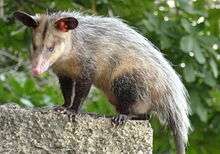







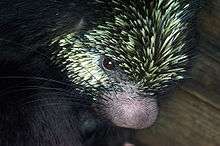
.jpg)
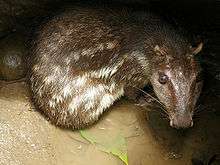




.jpg)






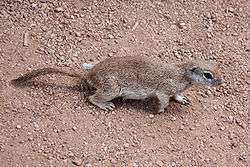


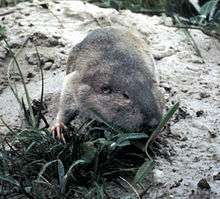
.jpg)

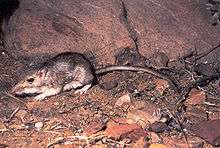


.jpg)









_001.jpg)


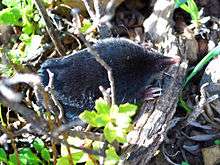


.jpg)
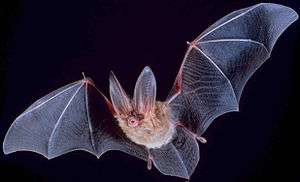






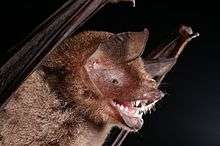






_crop.jpg)



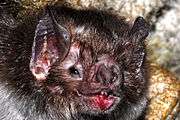

-8.jpg)











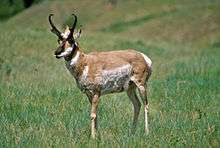
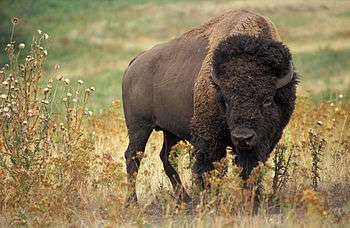


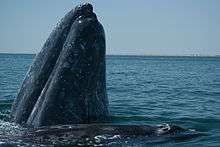

_NOAA.jpg)

_NOAA.jpg)



